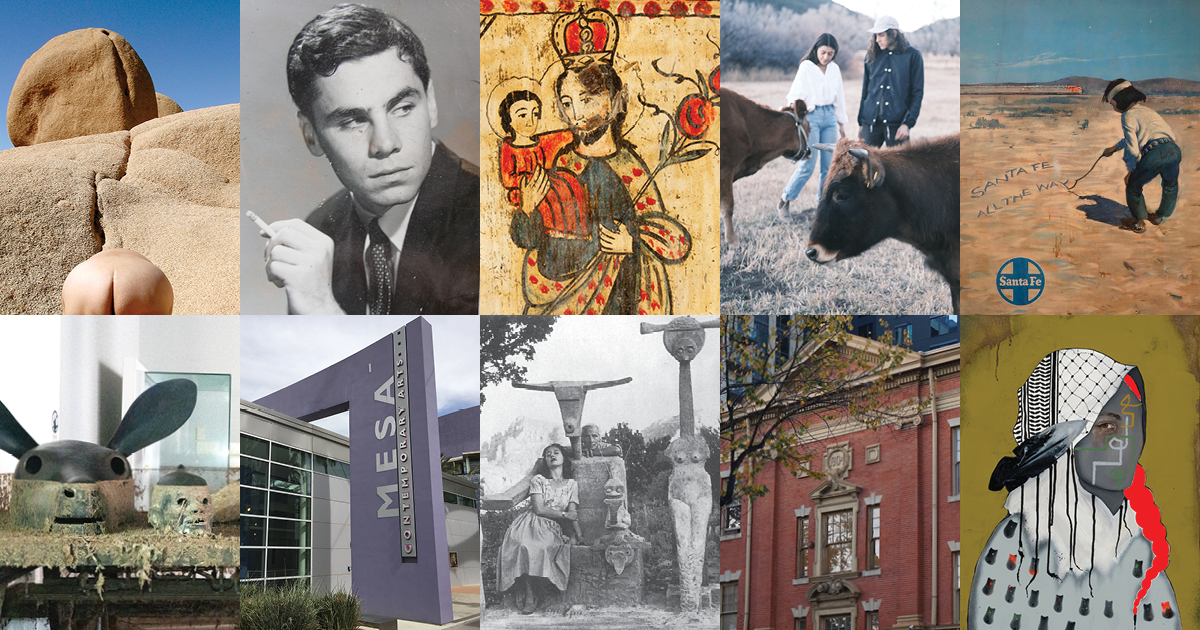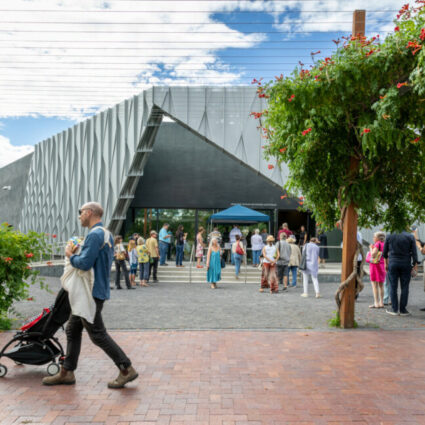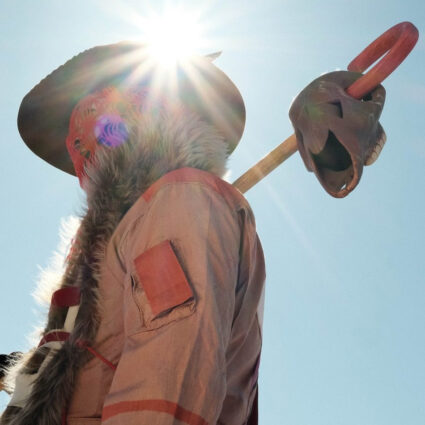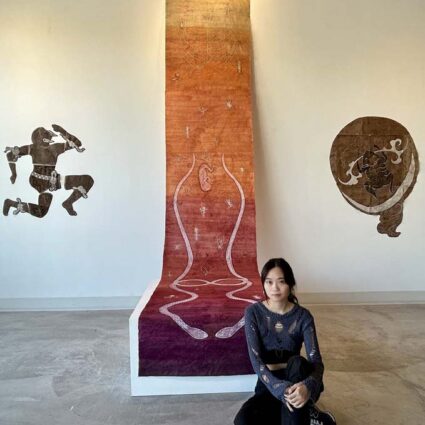Southwest Contemporary‘s most widely read stories of 2024 reflect some of the most urgent issues within the arts.

We spent 2024 rowing forward while looking back. Our year was bookended by our Living Histories and Radical Futures issues, and we spent much time as a team deeply engaged with creative practices rooted in inherited narratives or imagining new realities—and sometimes doing both. I started to see these themes threaded through most of the stories we told this year, including our top ten most-read articles.
Our most impactful stories of the year reflect urgent issues within the arts: reckonings with flawed cultural histories, the challenging conditions of the art industry, and artworks that truly inspire.
If you missed any of these stories, they are worth reading or re-reading. Of course, these are just a few of the incredible stories we shared this year. In all, we published 224 articles by seventy-one writers. We reviewed forty exhibitions at thirty-four venues, and highlighted countless artists. Consider exploring our Living Histories and Radical Futures themes, or catching up on our latest roundups of residencies or exhibitions.
Thanks for joining us this year!
The Top 10 Southwest Contemporary Stories of 2024:
10. Maida Branch and Johnny Ortiz-Concha: Life and Art as Sacred Continuum
by Erin Averill, May 24, 2024
In rural Northern New Mexico, artist Maida Branch (Ute, Pueblo, Genízara) and chef Johnny Ortiz-Concha (Taos Pueblo/Hispano) are redefining life, work, and art as spiritual practices interwoven with the land and the people they come from. In the 2025 New Mexico Field Guide, Erin Averill wrote about their projects Maida Goods and / shed project.
9. Analyzing Danielle SeeWalker’s G is for Genocide, the Artwork at the Center of a Vail Controversy
by Joshua Ware, May 17, 2024
Instances of censorship of artists speaking out about the Israel-Hamas war in Gaza have revealed painful schisms across the art world this year. This spring, complaints from Vail community members over Denver-based artist Danielle SeeWalker’s (Húŋkpapȟa Lakȟóta) Instagram post of her painting G is for Genocide led the Town of Vail to cancel her planned residency abruptly. Joshua Ware reported on the controversy for SWC, and the ACLU has since filed suit against the town on SeeWalker’s behalf, alleging her free speech rights were violated.
8. Selling the Southwest Unpacks the Colonialist Mythology and Marketing of the Santa Fe Railroad
by Camille LeFevre, May 2, 2024
At the Museum of Northern Arizona, Selling the Southwest exhibited fine art, objects, and marketing materials that were used to mythologize the Southwest and draw tourists to the Santa Fe Railroad and Fred Harvey Company destinations. “The Southwest’s landscapes were seen as sensational, stunning, sublime,” wrote Camille LeFevre. “The Southwest’s Indigenous people, seemingly untouched by ‘modern’ life, were portrayed as exotic, mysterious, innocent, and yes, subaltern: also, completely down with colonialism. Of course, nothing could be further from the truth.”
7. Death of Santa Fe Publishing Icon Guy Cross Stirs Tales of a Supercharged Southwest Art Moment
by Jordan Eddy, December 6, 2024
While Santa Fe was blossoming into a contemporary art hub from the late 1970s to the ’90s, Guy Cross’s multiple local publications were there documenting the scene. Cross, whose second publication The Magazine was the direct precursor to Southwest Contemporary, passed away this November. Jordan Eddy’s obituary considers Cross’s complex legacy and the cultural milieu he helped shape.
6. The Tanning-Ernst Effect: Is Sedona Poised for a Surrealist Renaissance?
by Camille LeFevre, March 1, 2024
Sedona was, for a time, a Surrealism outpost in the desert, where artists Max Ernst and Dorothea Tanning once lived and made work. In Southwest Contemporary Vol. 9: Living Histories, Camille LeFevre revisited the Surrealist art history of Sedona, as well as recent efforts to enshrine that history in a museum in the artists’ former home, Capricorn Hill.
5. Faced with Attributions Controversy, Harwood Museum of Art Publicly Edits Santeros Exhibition
by Jordan Eddy and Erin Averill, July 19, 2024
Ahead of the opening of Unknown Santeros at the Harwood Museum of Art in late February, a fierce debate unfolded online in which several Nuevomexicano artists expressed dismay about unattributed artworks in the display and the historically loaded implications of labeling nonwhite artists as “unknown.” Over months of in-depth reporting, Jordan Eddy and Erin Averill spoke with museum staff, community members, and scholars about the problematic origins of the Harwood’s santo collection, the museum’s delayed response to the criticism, and the curatorial challenges small museums face.
4. Evans School Exodus: Denver Artists Prepare to Leave the Historic Former Elementary School
by Madeleine Boyson, November 12, 2024
Investors are finally redeveloping the Evans School—a historic schoolhouse in Denver’s Golden Triangle District—and displacing nearly sixty artists from their low-cost studios in the process. While the school had become a haven for the art community, developers are moving forward with a mixed-use, public retail space. Madeleine Boyson reported on the project’s impacts and the challenges artists face in rapidly developing markets.
3. Former Curator of Mesa Art Museum Files Federal Lawsuit Alleging Censorship and Discrimination
by Lynn Trimble, November 5, 2024
Tiffany Fairall, the former chief curator of the Mesa Contemporary Arts Museum in Arizona, filed a lawsuit against the City of Mesa in November, following 2023 censorship allegations related to an artwork about police brutality by artist Shepard Fairey. The lawsuit accuses the City of Mesa of violating Fairall’s First Amendment rights to free speech but also alleges additional violations of federal law, “making it clear that the Shepard Fairey controversy reflects just a small part of Fairall’s concerns about the city’s policies and practices related to artists, curators, and the city-run museum located at Mesa Arts Center,” reported Lynn Trimble.
2. “The Doors Were Breaking, Things Were Moving”: Inside the Roswell Museum After Disastrous 500-Year Flood
by Natalie Hegert, December 19, 2024
Torrential flash flooding tore through the Roswell Museum this October, covering floors, walls, paintings, and sculptures in water, mud, and silt. Sculptures floated around rooms while glass display cases became “aquariums.” Museum staff spent two weeks rescuing thousands of pieces from the mud and sending them out for assessment and conservation. Now, the museum, which has been stripped of its floors and walls, faces a long and expensive process of remediation.
1. Landscape, Body, Identity: Laura Aguilar at Phoenix Art Museum
by Lynn Trimble, February 19, 2024
Laura Aguilar was popular this year, topping our list of most-read stories! Presented by the Phoenix Art Museum, Nudes in Nature includes work Aguilar (1959–2018) created in the landscapes of the Southwest region. Many photographs “show the artist’s own nude body,” wrote Lynn Trimble, “with its rotund cascading folds, set within natural environments where her physical form and poses often echo the water, rocks, and plant life that surround her,” exemplifying the artist’s critique of dominant norms of beauty, conformity, and female identity.



